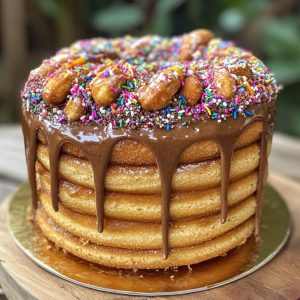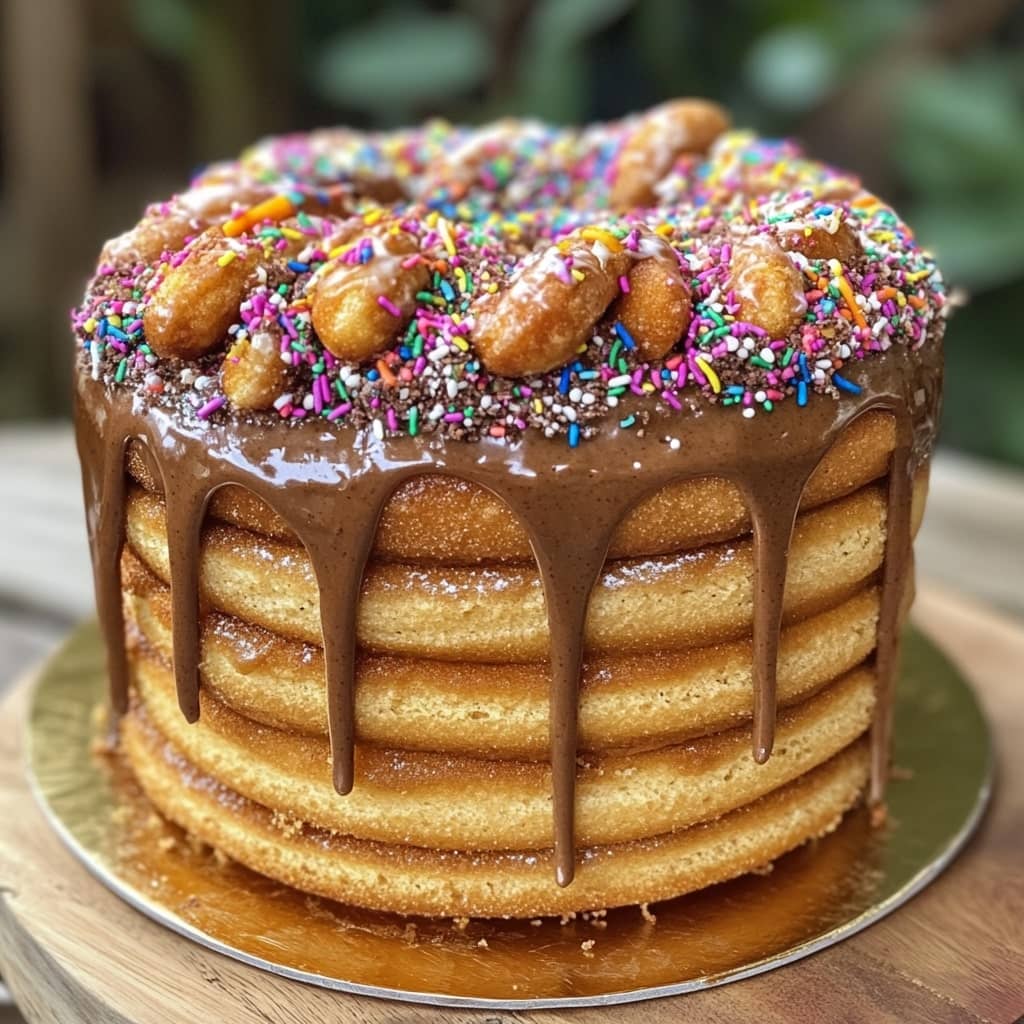Introduction:
Brown Butter Cake is an indulgent, moist dessert that takes a traditional cake to the next level by incorporating the nutty and rich flavors of brown butter. The deep, caramelized flavor of browned butter enhances the cake’s texture, making it more fragrant and flavorful than a typical cake. With its unique flavor and soft crumb, it’s perfect for special occasions or when you want to treat yourself to something extra special. This cake is versatile and can be enjoyed on its own, paired with frosting, or as part of an elaborate dessert.
The History of Brown Butter Cake:
Brown butter, known as “beurre noisette” in French culinary terms, has been used in cooking for centuries, particularly in French cuisine, to add depth of flavor to both savory dishes and desserts. The idea of incorporating brown butter into cake recipes has evolved as home bakers and pastry chefs looked for ways to bring an extra layer of complexity to their baked goods. Brown butter has become increasingly popular in the baking world, particularly in cakes, cookies, and frostings, where it transforms a basic recipe into something extraordinary. Brown Butter Cake is a modern creation that showcases this ingredient at its best—highlighting its toasty, caramelized richness while keeping the texture of the cake tender and fluffy.
Ingredients Breakdown:
For the Brown Butter Cake, you’ll need:
- Unsalted Butter: The foundation for the brown butter, adding both flavor and richness to the cake.
- All-Purpose Flour: The main dry ingredient that provides structure.
- Granulated Sugar: Adds sweetness to balance the richness of the brown butter.
- Baking Powder & Salt: For leavening and flavor enhancement.
- Egg Whites: Provide structure and stability to the cake while keeping it light.
- Sour Cream: Adds moisture, richness, and a slight tang, improving the cake’s texture.
- Vegetable Oil: Ensures moisture and helps with the cake’s texture.
- Vanilla Extract: For flavor depth.
For the Brown Butter Cream Cheese Frosting, you’ll need: - Brown Butter: Used in both the cake and the frosting for a rich flavor.
- Cream Cheese: Adds a tangy creaminess to the frosting.
- Powdered Sugar: Sweetens the frosting and helps achieve the right consistency.
- Heavy Cream: Provides the perfect texture and helps to smooth the frosting.
Step-by-Step Recipe:
- Make the Brown Butter: Start by browning the butter for both the cake and frosting. Cut the butter into small pieces and melt it over medium heat in a light-colored pan. Stir constantly to ensure the butter doesn’t burn. After 5–6 minutes, the butter will foam and then turn golden brown. Remove it from the heat immediately and pour it into a heatproof bowl to cool. Place the bowl in the fridge for about 45 minutes or until it solidifies and reaches room temperature.
- Prepare the Cake Layers: Preheat your oven to 350°F (175°C). Grease and line your cake pans with parchment paper. In a stand mixer, combine the flour, sugar, baking powder, and salt. Gradually add in the room-temperature brown butter, mixing until it resembles moist sand. Add the egg whites, sour cream, vegetable oil, and vanilla extract, mixing thoroughly. Once incorporated, beat on medium speed for about 30 seconds to ensure a smooth batter.
- Bake the Cake: Divide the batter evenly between your prepared pans and bake for 33-35 minutes. You can test for doneness by inserting a toothpick into the center of the cake—if it comes out with a few moist crumbs, it’s ready.
- Cool the Cake Layers: Let the cakes cool for 10 minutes in the pans before flipping them onto a wire rack to cool completely. For the best results, chill the layers in the freezer for 30 minutes.
- Make the Frosting: While the cake is cooling, make the brown butter cream cheese frosting. In a stand mixer, beat the cooled brown butter and cream cheese together until smooth and fluffy. Gradually add powdered sugar, then heavy cream. Mix until you reach a smooth, spreadable consistency.
- Assemble the Cake: Once the cake layers are cool, use a serrated knife to level the tops of the cakes if necessary. Stack and frost the layers with the cream cheese frosting. Decorate as desired and enjoy!
Tips for the Perfect Brown Butter Cake:
- Be sure to brown the butter slowly and carefully to avoid burning it. Once it’s browned, remove it from the heat promptly to stop the cooking process.
- Use room-temperature ingredients, especially the egg whites and sour cream, for a smoother batter and better cake texture.
- Ensure your cake layers are completely cooled before frosting to prevent melting the frosting.
- Level your cake layers with a serrated knife for even stacking and a smoother final result.
- For the frosting, if it becomes too thick, add a bit more heavy cream, one tablespoon at a time, until it reaches the desired consistency.
Variations and Customizations:
- Add a Flavor Twist: You can add different extracts to the cake, such as almond or hazelnut, for a unique twist.
- Add a Fruit Filling: Fresh fruit, such as berries or caramelized bananas, can be added between the layers for an added burst of flavor.
- Nuts and Crunch: Toasted pecans, walnuts, or almonds could be sprinkled between the cake layers or on top of the frosting for texture and additional flavor.
- Frosting Options: If you prefer a lighter frosting, you can substitute the cream cheese for mascarpone cheese, or even whip up a traditional buttercream frosting for a sweeter finish.
Health Considerations and Nutritional Value:
Brown Butter Cake is a rich dessert, and like many cakes, it’s high in sugar and fat. The brown butter contributes to its deliciously nutty flavor, but it also increases the calorie count. If you’re looking for a lighter alternative, consider reducing the sugar or opting for a lighter frosting made with Greek yogurt or whipped cream. As with any dessert, enjoy it in moderation as part of a balanced diet. For those with dietary restrictions, consider substituting ingredients like egg whites for a vegan option or using gluten-free flour for those with gluten sensitivities.
FAQ:
- Can I make the cake in advance? Yes, the cake layers can be made up to 2 days in advance. Just store them in an airtight container at room temperature or in the fridge.
- How do I store leftover cake? Brown Butter Cake should be stored in an airtight container at room temperature for up to 3 days or in the fridge for up to a week. It can also be frozen for up to 3 months.
- Can I use salted butter for the brown butter? It’s best to use unsalted butter to control the amount of salt in the cake. However, if you only have salted butter, reduce the amount of salt in the cake and frosting recipe accordingly.
- Can I substitute the sour cream? Yes, you can use Greek yogurt as a substitute for sour cream for a slightly tangier flavor and a lighter texture.
- How can I make this cake dairy-free? To make this cake dairy-free, substitute the butter for a plant-based butter, use a non-dairy sour cream alternative, and choose a dairy-free frosting.

Churro Layer Cake
Ingredients
For the Cake
- 3 ½ cups all-purpose flour
- 2 teaspoons baking powder
- ¾ teaspoon baking soda
- 1 teaspoon salt
- 2 teaspoons cinnamon
- ¾ cup unsalted butter room temperature
- ¼ cup canola oil
- 1 ½ cups granulated sugar
- 3 large eggs room temperature
- ¼ cup sour cream or Greek yogurt room temperature
- 1 tablespoon vanilla extract
- 1 ¼ cups buttermilk room temperature
For the Filling
- 1 cup unsalted butter room temperature
- 4 oz cold full-fat cream cheese
- 2 cups powdered sugar
- 1 tablespoon 2% milk
- 1 teaspoon vanilla extract
- 1 can dulce de leche store-bought or homemade
For the Cinnamon Sugar Coating
- ½ cup granulated sugar
- 1 teaspoon cinnamon
Instructions
To Make the Cake
- Preheat the oven to 350°F/180°C. Lightly grease the bottom of three 8-inch cake pans and line the bottoms with parchment paper rounds.
- In a medium bowl, whisk together the flour, baking powder, baking soda, salt, and cinnamon. Set aside.
- In a stand mixing bowl, cream the butter, sugar, and oil together for about 3 minutes until the mixture is white and fluffy.
- Mix in the eggs one at a time, ensuring each is fully incorporated before adding the next. Scrape down the sides and bottom of the bowl as needed.
- Add the vanilla and sour cream, mixing until combined.
- Add a third of the dry ingredients and mix until almost combined, then pour in half of the buttermilk. Continue alternating between adding the buttermilk and the remaining dry ingredients until everything is combined. Scrape down the sides and bottom of the bowl to ensure everything is well mixed.
- Evenly distribute the batter into all three cake pans, with about 471 grams in each.
- Bake the cakes directly on the middle rack for 18-20 minutes, or until a toothpick inserted into the center comes out clean.
- Let the cakes cool on a wire rack for 15 minutes. Run a spatula around the sides of the pans and turn them out onto the rack to cool completely.
To Make the Buttercream
- In a stand mixing bowl, beat the cream cheese on medium speed until smooth, then add the butter and mix until fully combined.
- Gradually add the powdered sugar, half a cup at a time, mixing on low after each addition.
- Add the milk and vanilla, then mix to combine.
- Increase the speed to medium for 30 seconds until the frosting is fluffy but still thick. Cover and refrigerate until ready to use.
- When ready to use, briefly mix the frosting for 20-30 seconds to soften it slightly, ensuring it is smooth but not too runny.
Assembly
- Mix together the cinnamon and sugar in a large bowl and set aside.
- Use a serrated knife to thinly cut off the skin of each cake layer to expose the crumb.
- Roll the sides of each layer in the cinnamon sugar mixture. If the sugar isn’t sticking, lightly brush the sides with melted butter or a simple syrup (recipe in notes), then roll until coated.
- Place one layer of cake on a cake stand, platter, or cardboard round.
- Use an offset spatula to spread ¼ cup of the dulce de leche on top, leaving a ½-inch border around the edges.
- Fill a large piping bag fitted with a large round tip with frosting. Pipe a ring of frosting about 1 inch high around the edge of the cake, then pipe a light zig-zag layer of frosting on top of the dulce de leche.
- Use a spatula to smooth just the center frosting to cover the dulce de leche. Do not smooth the border frosting!
- Place the next cake layer on top. Avoid pressing it down, as this will push the frosting out from the sides. Continue stacking the layers, topping the final layer with dollops of frosting around half of the top edge.
- Place the entire cake in the freezer and chill for at least 20 minutes, or until the frosting sets.
- Serve and enjoy!

